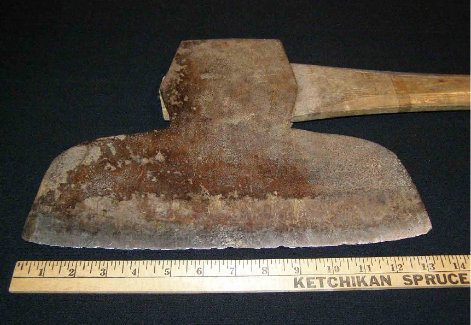Contributed by Richard Estelle
If your visions of a broadaxe come associated with a hooded executioner of the middle ages, then you might think it appropriate that the one in our collection is stamped “I. Blood” on the head. However, it’s safe to say that our axe was never put to such gruesome use.
Prior to common availability of sawmills for forming flattened sides on round logs, a broadaxe was the primary tool used for “hewing”, or squaring timbers, making flat surfaces on house logs or beams, and forming railroad ties.
This variety of broadaxe differs from a common woodsman’s axe in that the head is asymmetrical, formed flat on one side from the smaller “butt”, or head, to the wide blade edge, while on the other side, the head is flared to receive the handle and the blade is thickened in the middle. Only the thickened side of the blade is ground to a “basilled” or chiseled edge to sharpen it, leaving the other side flat. Typically, the steel boadaxe head is much heavier and wider than the woodsman’s axe. Ours weighs in at 10 pounds and measures 13-1/2” along the cutting blade and 9-1/2” from blade edge to butt. The head could be hafted with the handle extending in either direction for right or left-handed use.
“Hewing” involves cutting large chips from the rounded side of a log to remove wood down to a marked line where the flat surface is intended. Then, using the flat side of the axe, the flattened log surface is finished smooth. Often when logs were to be faced on only two sides, such as for railroad ties, the cutter would stand atop the log with a right-handed axe, (the sharpened side against the log) chopping in heavy scoring cuts on the right side as he walked its length, turning to return doing the same on the other side. Then, he’d switch to a left-handed axe (with the flat side against the log) and retrace his steps, removing the large chips and leaving a flattened surface.
Our axe, with its heavy head and straight handle, was likely used for rougher work as described above. For more finished timbers, a similar ax, but with a somewhat smaller head and with a bent handle allowing closer work and better cross grain cutting, would normally be used.
As hinted above, our axe was manufactured by Isaiah Blood of Ballston, Saratoga Co. N.Y., sometime between 1851 and 1892. Blood’s axes were famous for their quality and highly prized throughout the country.


















































